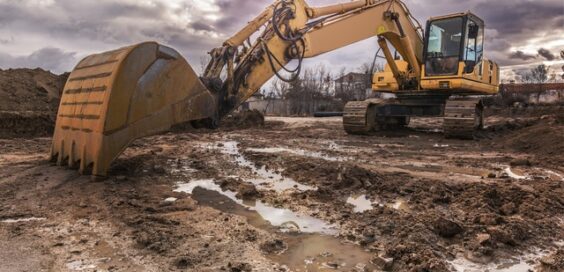6 Top Safety Guidelines for Excavator Use in Rain
Written by SayBuild-admin // August 11, 2025 // Construction Equipment // Comments Off on 6 Top Safety Guidelines for Excavator Use in Rain

Constructing a new home or structure on your property requires careful planning, especially if the project calls for heavy machinery. Many people will plan their construction projects on clear, sunny days, but the weather is unpredictable, and you may find your operation washed out by a sudden storm. When you need to use an excavator in the rain, follow these top safety guidelines to navigate through puddles and mud with ease.
1. Inspect Your Excavator Before Starting
Heavy rain can increase the likelihood of mechanical failures. Before operating your excavator in wet conditions, carefully inspect the machine so that everything is functioning properly. Check the brakes, hydraulic systems, and tire or track conditions to reduce the chance of breakdowns and prevent accidents.
During your inspection, remind operators to turn off the engine during extended pauses to reduce idling on your construction site. This conserves fuel and minimizes unnecessary strain on the machinery
2. Use the Right Attachments for the Job
Mud and wet earth can place additional strain on your excavator. To prepare for any sudden weather changes, equip your machine with specialized attachments, such as mud buckets or tracks designed for wet terrain. These tools provide extra traction and prevent slippage on construction sites.
3. Minimize Water Accumulation in the Work Zone
Before starting any heavy trenching or excavation, assess the area and drain excessive water. Creating small trenches or pathways will also redirect water to prevent slipping hazards. This will lower risks for your excavator operators and keep your job site functional.
4. Slow Down and Avoid Sudden Movements
Using an excavator in the rain safely requires more caution, so go slow when maneuvering through mud or uneven surfaces to maintain equipment control. Because sudden movements can cause the excavator to tip or skid, staying consistent and deliberate with your actions will reduce wear on your powertrain components.
5. Monitor Visibility Closely
Rain impairs visibility, making it difficult to see hazards around your work site. If the rain becomes heavy, use the windshield wipers to keep mirrors clear of mud or water splashes. For extra safety, install worksite lights and ask a ground crew to provide guidance if visibility is too low.
6. Test Water Depth Before Entering Puddles
Rain often creates deep puddles that can unexpectedly trap your excavator. If you notice deep trenches of water, stop and test the depth of any water accumulation before driving through it. If water looks too deep to cross safely, adjust to your route or wait until conditions improve to avoid damaging your machine.
If you or your staff don’t feel comfortable working in the rain, park the vehicles in a safe area and relocate your equipment. Excessive water can damage your tools and materials, especially if these materials are susceptible to rust. With these tips in mind, you can protect your equipment from severe damage and finish your construction project with minimal distress.
Image Credentials: By Enrique del Barrio, 262198242








 If you want to contribute tutorials, news or other money-related stuff:
If you want to contribute tutorials, news or other money-related stuff:  Share our home building library with your facebook friends:
Share our home building library with your facebook friends:  Do you have any ideas or suggestions you would like to make?
Do you have any ideas or suggestions you would like to make?  If you like what we do, please subscribe to our
If you like what we do, please subscribe to our  All content Copyright © 2012 SayBuild. Part of nBuy Home Management Network.
All content Copyright © 2012 SayBuild. Part of nBuy Home Management Network.